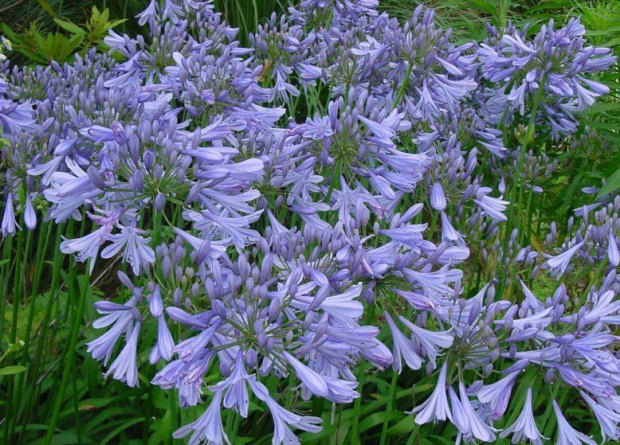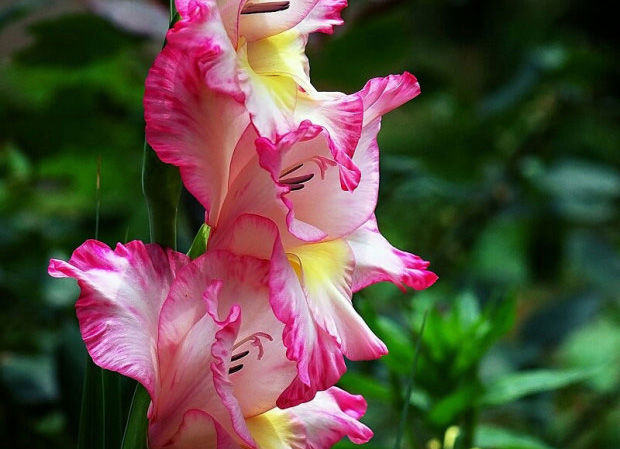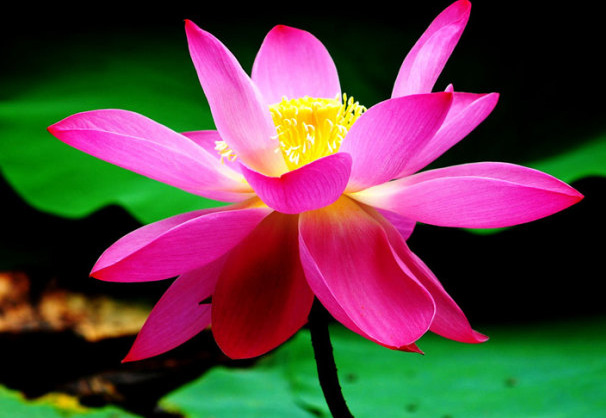Cultivation and culture methods of Baizi orchid (Baizi lotus)
Baizi orchid gets its name because of its many flowers and seeds, and its leaves are close to orchid, so it is also called purple orchid because its posture is close to that of gentleman orchid, but it is also called purple orchid; Shanghai, Hangzhou and other Jiangnan areas are also called Baizilian. Perennial evergreen rhizomatous herbs, leaves banded, about 80 cm long, basal, arranged in two rows; scape in June, about 60 cm high, apex curved and pendulous, recurrent flowering, 2060 flowers per inflorescence, florescence as long as 1 month. In cultivation, there are double, white, purple and Phnom Penh leaves, silver-edged leaves and other varieties. Originated in South Africa, warm, humid climate and semi-shady environment, avoid exposure; summer should be shaded and ventilated places; not strict requirements for soil, but poor growth on clayey soil and barren sandy soil, to fertile, humus-rich soil with good drainage, the best growth.

It is most convenient to propagate separately in family cultivation. In South China, it can be planted in the open field, while in the Yangtze River Basin and the north, it can be planted in pots, overwintering indoors, and the room temperature is more than 5i in winter. Spring combined with changing pots for separate planting, the rhizome can be cut off and planted in a new pot. About half a month after planting, the seedling stage should be fully supplied with water and fertilizer, and it can blossom one year after planting. In the summer of exuberant growth, thin and spicy liquid fertilizer or sheet water should be irrigated once a week; fertilization should be based on phosphorus and potassium, and nitrogen fertilizer should not be too much, otherwise it is easy to cause overgrowth, hypertrophy of leaves and few flowers. After entering October, the weather gradually turned cool, and the plant entered a semi-dormant state until April of the following year; during this period, watering should be controlled and fertilization should be stopped to avoid germination and growth and affect flowering. The semi-dormancy period in the south is shorter, and it should also be noted that the old leaves should be cut off before the new leaves germinate in spring to keep the plant clean and tidy. How to cultivate and cultivate Baizi lotus, some people call it purple orchid, a perennial herb of Amaryllidaceae, with two rows of broad lanceolate leaves, dark green, underground with short thick fleshy roots, flower pavilion 6090cm high, terminal corymbose, flowers about 15ml 30 machine, flower blue, florescence 6rel 8 months, very beautiful. When there are no flowers, the foliage can also be seen, so the florists like to appreciate the potted plants.
Baizi lotus originated in South Africa, sexual love warm and humid, not very cold, like the sun, but afraid of the hot sun, a little shade, good fertilizer, should grow in sandy loam soil rich in humus and good drainage. The cultivation of this flower is mainly ramet, which can be carried out in spring and autumn, and autumn is generally better. Because of the ramet in spring, it can not blossom in the same year. Potted plants are divided once every 3 years or so. If the plants are not divided for a long time, the growth and flowering will be affected. When ramet, each new plant should carry 2 Mel 3 buds, which should be placed in the shade for a week and then moved to the sun. If the sowing method is used, it will take more than 5 years to blossom, so this method is rarely used. 3 parts of garden soil, 1 part of rice chaff ash and 1 part of compost should be used in the cultivation of Baizi lotus. Maintenance should be placed in a semi-shady and humid place. From June to September, we should pay attention not to let the scorching sun shine directly, so as not to burn the leaves. Watering is moist, wet between dry and dry, especially in summer to ensure adequate moisture, and often spray water in the plant and the surrounding environment to humidify and cool down. The day before fertilization, watering should be suspended to make the basin soil collect water; after fertilization, the leaves should be sprayed with clean water, and the fertilizer should be used alternately with manure, cake fertilizer and chemical compound fertilizer, once every 15 days. For ramet seedlings, sufficient fertilizer and water should be given to make them blossom early. After blooming, you should pick the flowers and apply fertilizer in time. Stop fertilizing after October, and move to the indoor wet place when the temperature drops to 1 ℃ 2 ℃, and keep it above 0 ℃ to survive the winter. at this stage, we should pay attention to control watering and keep the basin soil slightly moist, not more watering. The breeding method of Baizi lotus is also called purple magnolia, which is a perennial herb of Amaryllidaceae, with two rows of wide lanceolate leaves, dark green, underground with short thick fleshy roots, flower pavilion 60-90 cm high, terminal corymbose inflorescences, flowers about 15-30 machines, flower blue, florescence 6-8 months, very beautiful when there are no flowers, the foliage can also be seen, so the florists like to appreciate it in pots. Baizi lotus originated in South Africa, sexual love warm and humid, not very cold, like the sun, but afraid of the hot sun, a little shade, good fertilizer, should grow in sandy loam soil rich in humus and good drainage. The propagation of this flower is mainly ramet, which can be carried out in spring and autumn, and autumn is generally better. Because of the ramet in spring, it can not blossom in the same year. Potted plants are divided once every 3 years or so. If the plants are not divided for a long time, the growth and flowering will be affected. When ramet, each new plant should have 2-3 buds, which should be placed in the shade for a week and then moved to the sun. If the sowing method is used, it will take more than 5 years to blossom, so this method is rarely used. 3 parts of garden soil, 1 part of rice chaff ash and 1 part of compost should be used in the cultivation of Baizi lotus. Maintenance should be placed in a semi-shady and humid place, June-September should be careful not to let the scorching sun direct, so as not to burn the leaves, watering to moist, dry and wet, especially in summer to ensure adequate moisture, and often spray water in the plant and the surrounding environment to humidify and cool. The day before fertilization, watering should be suspended to make the basin soil collect water; after fertilization, the leaves should be sprayed with clean water, and the fertilizer should be used alternately with manure, cake fertilizer and chemical compound fertilizer, once every 10-15 days. For ramet seedlings, sufficient fertilizer and water should be given to make them blossom early. After blooming, you should pick the flowers and apply fertilizer in time. Stop fertilizing after October, and move to the indoor humid place when the temperature drops to 1-2 ℃, and keep it above 0 ℃ to survive the winter. at this stage, we should pay attention to control watering and keep the basin soil slightly moist, not more watering.
- Prev

Cultivation and Management methods of Gladiolus
Sword leaves like calamus, long stems drawn, full of bone pods, all kinds of funnel-shaped flowers bloom one by one, people like to cut off the flower stem and insert it in a vase, leaving the root, the flower should also be placed straight to the top. This is a portrayal of the basic characteristics of Gladiolus. Its aliases are: calamus orchid, sword orchid, assorted variety, 13 Taibao, flat bamboo lotus and so on.
- Next

Culture and conservation methods of lotus
The effluent hibiscus is strong, born in the sludge, the beads roll on the leaves more chic, and the whole body has a wide range of uses. This vivid limerick, the praise of the lotus is very appropriate, showing the strong character of the lotus in the mud. With its tall and straight peduncle against a large disc-shaped leaf.
Related
- Fuxing push coffee new agricultural production and marketing class: lack of small-scale processing plants
- Jujube rice field leisure farm deep ploughing Yilan for five years to create a space for organic food and play
- Nongyu Farm-A trial of organic papaya for brave women with advanced technology
- Four points for attention in the prevention and control of diseases and insect pests of edible fungi
- How to add nutrient solution to Edible Fungi
- Is there any good way to control edible fungus mites?
- Open Inoculation Technology of Edible Fungi
- Is there any clever way to use fertilizer for edible fungus in winter?
- What agents are used to kill the pathogens of edible fungi in the mushroom shed?
- Rapid drying of Edible Fungi

